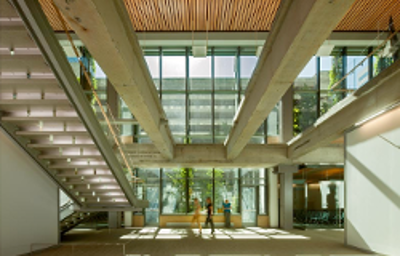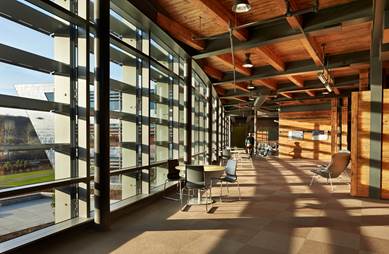Circadian Light For Your Health
 The use of daylighting in buildings has focused primarily on reducing energy consumption and providing pleasant interior environments. However, light, especially daylight, may be good for one's health through impacts on the body's circadian rhythms. Given that people spend a majority of their waking hours indoors at work, daylight- if appropriately engineered and supplemented by electric light when necessary - may have unrecognized health benefits.
The use of daylighting in buildings has focused primarily on reducing energy consumption and providing pleasant interior environments. However, light, especially daylight, may be good for one's health through impacts on the body's circadian rhythms. Given that people spend a majority of their waking hours indoors at work, daylight- if appropriately engineered and supplemented by electric light when necessary - may have unrecognized health benefits.
 What are Circadian Rhythms and What is Circadian Light?
What are Circadian Rhythms and What is Circadian Light?
A person’s "body clock" is regulated by circadian rhythms, which are physiological processes that occur approximately every 24-hours. These 24-hour rhythms have also been widely observed in plants, animals, fungi, and even bacteria. An example of a circadian rhythm is a person’s wake/sleep cycle. A function of light is to entrain the body’s circadian system to the solar day so that the wake/sleep cycle is entrained or synchronized with the natural light/dark cycle on Earth. If a person's circadian functioning is entrained, a person sleeps well at night and is alert during the day.
Purpose of GSA's Circadian Research
GSA's research has been focused on identifying the links between the amount of light people receive at work and their wake/sleep patterns, daytime alertness, and emotional functioning. GSA's overall goal is to identify specific health benefits of lighting practices that can be replicated in new and existing buildings to achieve innovative and cost effective ways to improve employee health and well-being at work.
GSA conducted this research in several phases. The first phase consisted of taking both space and personal circadian light measurements, and the results showed that while daylight is valuable, it is an insufficient source of circadian stimulation when used alone due to occupant behavior, interior design, low levels of daylight penetration, and other circumstances. In the first phase, GSA conducted its research in five of its buildings in different geographical locations and in both the summer and the winter to account for seasonal variability in daylight.
- GSA Headquarters, Washington, DC
- Edith Green-Wendell Wyatt Federal Building, Portland, Oregon
- Federal Center South Building 1202, Seattle, Washington
- NCR Regional Office Building, Washington, DC
- Wayne N. Aspinall Federal Building and U.S. Courthouse, Grand Junction, Colorado
The second phase of the research explored supplemental electric lighting solutions and other best practices that can be readily adapted to existing spaces in order to improve circadian functioning of all the occupants. The fieldwork was conducted at the Federal Highway Administration Turner Fairbanks Highway Research Center in McLean, VA and at the VA Medical Center in White River Junction, VT.
- FHWA and VA Medical Center, McLean, VA and White River Junction, VT
The third phase focused on dynamic lighting solutions using short wavelength electric light in the morning that changed to longer wavelength light in the afternoon to test the impacts to daytime alertness. Phase three was conducted at the headquarters for the U.S. Department of State in Washington, DC.
- U.S. Department of State, Washington, DC
Published Studies:
Figueiro MG, Steverson B, Heerwagen JH and Rea MS. 2015. Daylight in office buildings: impact of building design on personal light exposures, sleep and mood. 28th CIE SESSION. Manchester, UK. June 28-July 4, 2015
Figueiro, M.G., M Kalsher, BC Steverson. Circadian-effective light and its impact on alertness in office workers. Lighting Research and Technology. Jan 2018.
Figueiro MG, Steverson B, Heerwagen J, Kampschroer K, Hunter CM, Gonzales K, Plitnick B and Rea MS (2017). The impact of daytime light exposures on sleep and mood in office workers. Sleep Health 3(3): 204-215.
MG Figueiro, PhD, B Steverson, MA, J Heerwagen, PhD, R Yucel, PhD, C Roohan, BS, L Sahin, PhD, K Kampschroer, MS, MS Rea, PhD. Light, entrainment and alertness: A case study in offices [PDF]. Journal of Lighting and Research Technology. Nov 8, 2019.
What We Have Learned So Far
- People receive more light at work than anywhere else
- The best time of day for circadian stimulus is in the morning for at least 30 minutes
- People seated near windows and on higher floors receive more circadian stimulus
- Daylight is sometimes not enough; even in well-daylit buildings, there are pockets of biological darkness and low levels of circadian stimulus that may require additional electric light
- Interior workspace design can aid or limit daylight exposure
- Occupant behavior matters in promoting or diminishing circadian stimulus
- Shade use, primarily to reduce glare on computer screens, also reduces circadian stimulation if shades are not adjusted when glare is no longer a problem

 U.S. General Services Administration
U.S. General Services Administration